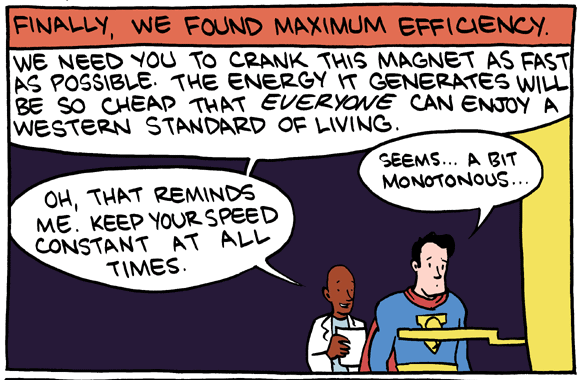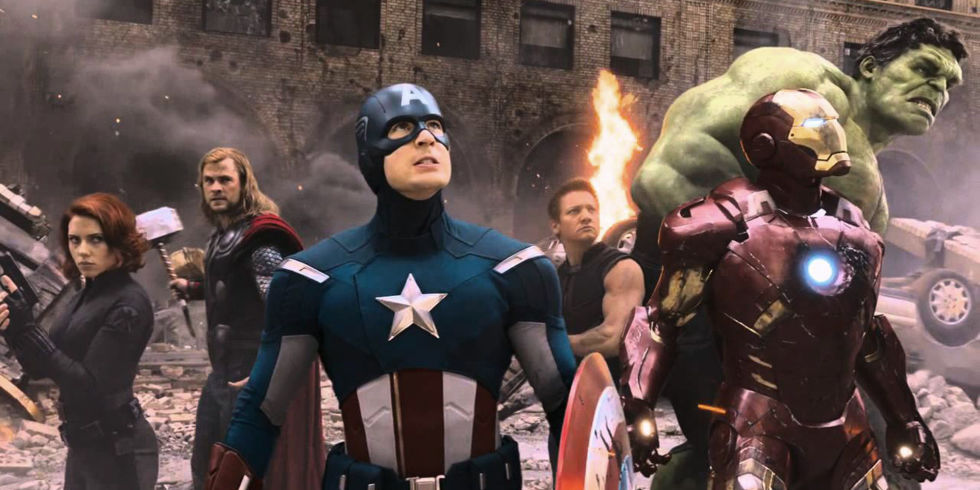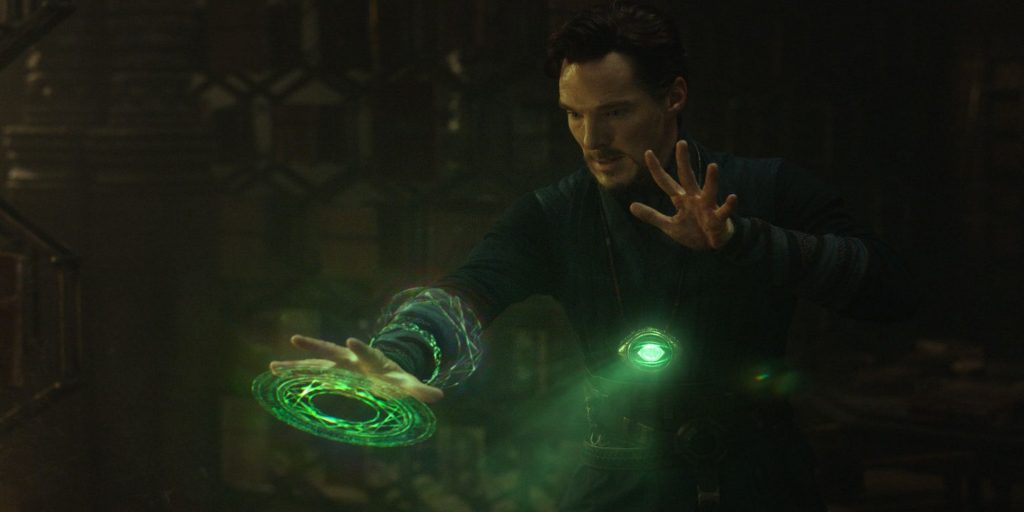One of the big ironies of superhero comics and movies is that these beings of immense power, though committed to saving the world, do so by punching things pretty hard. Even when far more obvious solutions to world shaking challenges are presented, the question is not “what will do the most good for the most people” but “can I punch at it really, really hard?” Superman could have done far more for his adoptive home world if he used his limitless strength to turn a crank on an alternator.

Heroes in the Marvel Cinematic Universe don’t fair much better. While off avenging, sorcering, and civil warring, they’ve managed to overlook some fairly self-evident solutions to the most pressing global crisis of our time. So how could Earth’s Mightiest Heroes bring an end to runaway climate change?
1. Tony Stark creates unlimited free energy.
We can get the obvious one out of the way, first. Stark’s Arc Reactor is, for all intents and purposes, a free energy machine. Miniaturization means Arc Reactors could be used to power anything, from cars to aircraft carriers to entire cities. Switching the world’s power grid and transportation network to Arc tech would result in an immediate reduction in CO2 emissions and halt the accumulating damage of continuous energy growth as demand for technology increases around the world.
Ok, that’s the obvious one that has to be mentioned in order to avoid insufferable Twitter comments. Now on the the good stuff.
2. Use Pym Particles to sequester CO2 in the Quantum Realm.
Pym Particles are particles that “shrink the spaces between atoms” allowing an object bombarded with these particles to shrink continuously while maintaining its mass, unless it’s a tank on a key-chain, for some reason. Comic books are ridiculous, ok?
Unfortunately, the shrinking power of Pym Particles is limitless, and once an object shrinks to the point where it’s smaller than an atom, somehow, it enters the Quantum Realm, where the laws of Newtonian physics no longer apply, time is meaningless, and you can never escape (except when you can). Shrink into the Quantum Realm and you shrink forever. That really seems like the ideal place to sequester CO2 , doesn’t it?
The big problem with carbon sequestration is that it’s not always a permanent solution. Sequestered CO2 in trees is only sequestered so long as no one cuts those trees down and burns them. The carbon is still out there in the world, waiting to be re-mobilized into the environment. But! If we could sequester carbon by bombarding it with Pym Particles and sending it to the Quantum Realm, it would shrink forever, permanently locked away in a world of very poorly interpreted quantum physics. That seems safe.
3. Embrace the Wakandan model of anti-colonial resource autonomy.
The Paradox of Plenty describes a phenomenon in which nations, particularly in the global south, with an abundance of natural resources tend to have less economic growth, less democracy, and worse development outcomes than nations with fewer natural resources, due largely to long histories of colonial exploitation which prevents the accumulation of wealth and political autonomy. It’s why the US, Great Britain, and Russia have been in some form of war in Afghanistan since before Moby Dick was published (seriously, right after “Call me Ishmael” Melville goes on to muse about contested presidential elections and bloody wars in Afghanistan). It’s why India had the world’s largest economy for 2000 years before the British Crown decided that they wanted in. It’s why coltan from the Democratic Republic of the Congo is one of the bloodiest and most valuable deposits on the planet. And you better believe that our love of smartphones and the resources they demand play an outsized roll in how all of this goes down.
Not so Wakanda, which, thanks to centuries of isolation, has retained both it’s political autonomy and control over the most valuable ore deposit in the nine realms, the massive vibranium meteor upon which Wakandan technology is built. By avoiding 4 centuries of European colonialism in Africa, Wakanda was able to grow in ways that no other nation could, producing sustainable, clean energy, mind-blowing technologies, and a system of government centered around waterfall-boxing (look, as Killmonger pointed out, isolationism is definitely not the best approach to every problem).
Creating a future with more equitably distributed wealth and resources means that those nations disproportionately affected by climate change have a louder voice and greater influence over how and why we pursue solutions to this global crisis. Climate change is a environmental justice issue.
Here’s some white people talking about the paradox of plenty as it applies to Africa:
And speaking of geoengineering…
4. Increase the Earth’s albedo with the God of Thunder.
Albedo refers to how much solar radiation is reflected off of a large object, like, say, a planet. The greater the albedo, the more radiation is reflected back into space. The lesser the albedo, the more radiation is absorbed by the planet. And that makes things hot. Ice sheets, sea ice, glaciers, and other reflective features play a significant roll in determining the Earth’s albedo. As sea ice melts, particularly in the Arctic, local warming increases, causing more sea ice to melt in a lovely little feedback loop.
But ice isn’t the only reflective structure on the planet. Everything from roads to roofs have been considered for increasing the albedo effect. One of the many tantalizing suggestions is to build ocean-going machines that seed the sky with seawater, producing clouds in their wake to increase reflection in the atmosphere. Albedo Yachts sound like the kind of solution that belongs in a comic book, anyway.
But why invest in tech when you’ve got your own portable thunderstorm? Has anyone even asked Thor?
5. Shoot an arrow at the sun.
Oh Hawkeye, why are you even here?

6. Reverse time with the Eye of Agamotto and the Time Stone.
Of all the means by which Marvel heroes could manipulate the world, none is more powerful or more comprehensive than Dr. Strange opening the Eye of Agamotto and reversing time. We’ve seen Dr. Strange reverse time for individual object as well as entire neighborhoods, while the rest of space continues to march forward, inexorably, towards entropy and the heat death of the universe. He’s even trapped entire pocket universes in infinite time loops.
Have I mentioned that comics are ridiculous?

By pointing his arm-wavy iPod interface towards the sea and sky, Dr. Strange could reverse two centuries of human impact, setting back the clock on carbon emissions, ocean acidification, and sea ice decline. With a little extra effort, he could restore fish and whale populations to their former glory, restore oysters populations in the Chesapeake Bay, remove lead, mercury, and plastic from the global ecosystem, and finally fix that pesky, stubborn ozone hole.
For a supreme, magical guardian of the Earth, Strange sure seems to have a particularly narrow vision of what that entails. Of course, the Eye of Agamotto is also an Infinity Stone, and using it could draw some very unwelcome attention…
7. Thanos could just flat out murder half of us.
The Mad Titan knows that cutting our resource demands in half (or more, depending on who Thanos deems unworthy of existence) would relieve significant pressure on the planet and allow space for environmental recovery, perhaps, in part, fulfilling his desire to restore balance to the universe. This is not a particularly desirable outcome.
For some real solutions to climate change, you should check out Drawdown: The Most Comprehensive Plan Ever Proposed to Reverse Global Warming. I highly recommend getting a hard copy, rather than an ebook, since it is beautifully produced.
If you enjoy Southern Fried Science, consider contributing to our Patreon campaign. For just $5 per month, you can support the SFS Writers Fund, which helps compensate your favorite ocean science and conservation bloggers for their efforts.